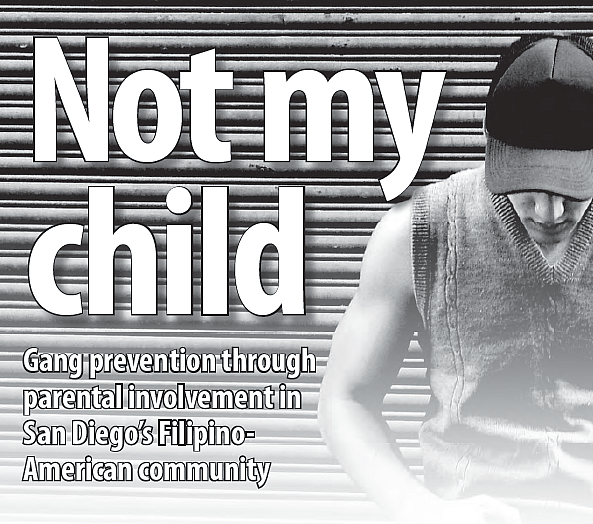Not My Child Part II
Alicia DeLeon-Torres explores common themes leading to youth gang involvement in the San Diego area.

The story is almost always the same. The first time parents find out their son or daughter is involved in gang activity is when the police officer comes to door and makes an arrest. Sometimes officers are met with crying or angry parents. Other times, the front door is slammed in their face. Most often, the officers encounter parents who are in denial or blindsided because they truly didn’t know.
“For Filipino-Americans, family and cultural heritage strongly impact the way the youth act around their elders versus how they act with their peers,” said Dr. Reynaldo Monzon. “No matter what kind of trouble that youth may get into, they don’t want to disappoint their parents. They’re the good kid at home, the good student in school and the gang-banger with their friends. They tend to lead double lives.”
Monzon is one of the few researchers in the nation who has studied Filipino-American family expression and youth behavior in a culturally sensitive and competent manner. He is also one of the original community leaders who assisted in developing gang-prevention and intervention training during the late 1980s, when Filipino gangs first became known to San Diego law enforcement.
San Diego Police Department Lt. Rudy Tai agrees with Monzon.
“The one thing that people like about Asian-American and Pacific-Islander communities is that they are family oriented. It’s a positive thing. But parents are also very busy with their jobs, church and community obligations,” said Tai, who is also a national trainer on Asian-American and Pacific-Islander gang-prevention and intervention.
“Many of the parents come from different countries or jurisdictions — they may not be aware of certain things, like signs for gang involvement,” he added.
While several agencies and schools offer parental gang awareness training, they rarely get Filipino-American parents to attend. Pureza Bacor, former mentorship director at the Union of Pan Asian Communities, offers insight.
“Most Filipino-American parents think their child would never be involved in gangs. It’s going to be someone else’s child,” she said.
Still others in community service maintain that those doing the training are “old school,” meaning that they use a “cookie-cutter” approach with the information and how it’s presented. Social service providers and law enforcement officials agree that Filipino parents need to become more aware of youth issues, know what their children are involved in and who their friends are.
“Just because the parents are busy, it doesn’t mean the kids are. They’re looking for something to do,” said Tai. “Help them build their self-esteem. Let them be involved in school, sports and other worthwhile activities that will keep them out of gangs and way from gang violence. Talk to them about consequence. Don’t wait until later. Don’t wait until the time is right — that time may never come. At best, kids will be OK and find positive role models and activities by themselves. At worst, they could become involved in gangs or become a victim of gang violence.”
Signs your child may be
involved in gangs
• Likes to wear clothing that is the same color for almost everything (e.g., all red, all blue, all yellow, etc.);
• Gang graffiti on notebooks, books, photo albums, bedroom adornments, inside their closet, MySpace or
Facebook page, etc.;
• Use of gang signs (e.g., hand signs) and;
• Pictures (hand signs, involving weapons, other gang members, etc.).
These are additional signals that youth may be involved in gangs, but could also be signs of other illicit behavior such as drug use:
• Staying out late or all night;
• Strange or cryptic phone calls or texts;
• Sudden change in friends;
• Arrogant or defiant attitude;
• Have money without having a job; and
• Use of illicit drugs.

